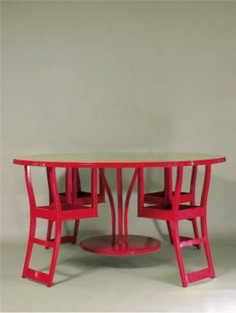WU YIMING
邬一名
table chair

source: soterioustephanieblogspot
A classical table it can be converted into a modern table with bright colours such as the colour red. I would use such a table in a modern style apartment. The reason it is modern is that the upside down chair are used as legs.
.
.
.
.
.
.
.
source: randian-online
WU Yiming, born in 1966 and graduated from the Fine Arts Department of the East China Normal University in 1992, now lives and works in Shanghai. His recent exhibitions include: Wu Yiming Solo Exhibition, Mind Set Art Centre, Taipei (2014); The Other Side of Time-WU Yingming Solo Exhibition, ShanghART Gallery, Shanghai (2012); Growing, The 15th Anniversary Exhibition of ShanghART Gallery, Shanghai World Financial Centre, Shanghai (2011); Portrait, ShanghART Gallery (Main Space), Shanghai (2010), Shanghai; Another Scene, ShanghART Gallery H Space, Shanghai (2009); The World of Other’s, A Contemporary Art Exhibition, Museum of Contemporary Art, Shanghai (2008).
.
.
.
.
.
.
.
source: artsynet
Chinese, born 1966–31
BIOGRAPHY
“I try to express that today’s people are fashionable but empty or shallow in mind,” says Wu Yiming, explaining the rationale behind the faceless, ink-wash figures for which he is known. Wu has likewise created faceless versions of famous sculptures including the Statue of Liberty, Buddha, and a work by Joseph Beuys. The technique of ink-wash and use of rice paper connect Wu’s painting to ancient artistic traditions, but early on he switched from portraying people in antique costumes to contemporary attire, professing that he does not want to live in the past. More recent paintings have moved away from human figures altogether, instead depicting landscapes and portrait-like renderings of plants. Candelabras, with their religious connotations, constitute another of Wu’s subjects: “I am always pondering the relationship between human beings and religion,” he says.

